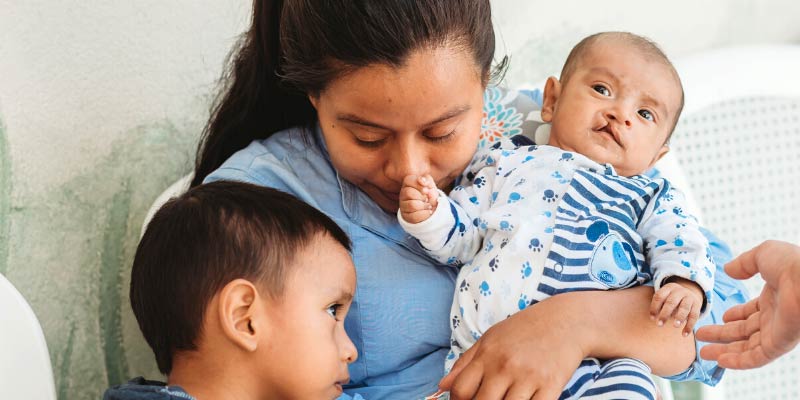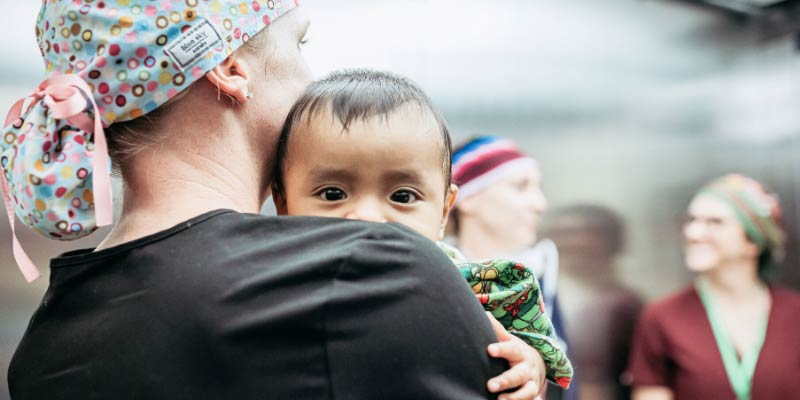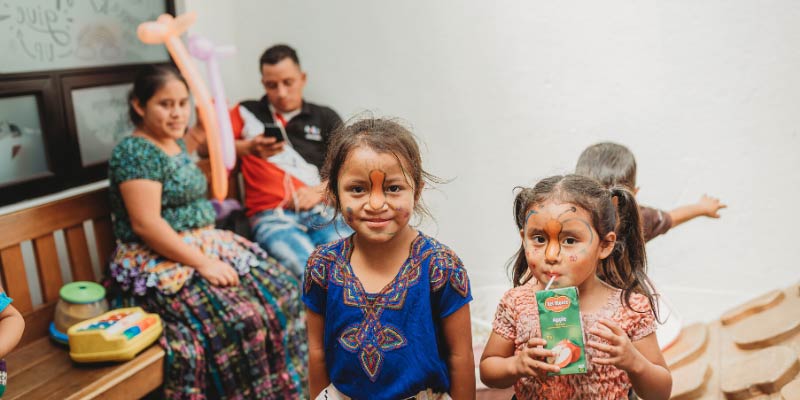by John Paschal
It is 9 o’clock on Tuesday morning, and two-year-old Herminia de la Cruz is already a rock star.
True, the little girl in pigtails is not singing a power ballad in front of thousands of worshipful fans, nor is she freestyling on a Fender Strat while security guards push groupies off stage. What she is, in the triage room of Hospital Militar Central, is the latest embodiment of an appropriate cliché. Herminia is the center of attention.
No fewer than six Austin Smiles team members are crowded around the girl as she sits at the edge of an exam bed. A passerby would expect to see at least a few paparazzi. Problem is, Herminia has refused to play to the crowd. Jennifer Skinner, a volunteer administrator from Austin, is engaging the girl with the universal language of baby talk, designed to draw a smile. Maria del Carmen Ugarte, a volunteer translator from Spain, is wielding a hand puppet, designed to draw a laugh. The plan, however, has gone awry. Granted, Herminia isn’t crying.
She hasn’t shed even a single tear.
She has refused, however, even to grin.
Call it a draw.
Herminia, wearing a polka-dotted dress and little brown boots, is one of the 11 patients scheduled to undergo surgery today as part of Austin Smiles’ 46th medical mission to the Central American country of El Salvador. Across its 31-year history, the nonprofit organization from Central Texas has served more than 4,000 patients during more than 80 medical trips to countries that have also included Brazil, the Dominican Republic, Cuba, Ecuador, Guatemala, Mexico, Micronesia, Nicaragua and the Philippines.
Studies have determined that children in Latin American countries, as compared to children in the United States, are roughly two times more likely to be born with orofacial clefts. In fact, about one in seven Latin American children is born with a cleft lip and/or cleft palate. For that reason, Austin Smiles has devoted most of its energy and resources to the Latin American region since its inception in 1987.
The mission, this and every time, is complex in execution but simple in initiative: to create better lives by creating better smiles. Right now, however, the plan still hasn’t worked on Herminia. Stoic as ever, the toddler is practically stiff-arming the Austin Smiles contingent. A change of hand puppets has done nothing to alter the girl’s expression. A rubber toy with a flashing light has failed to bring a smile to Herminia’s face.
“Tough girl,” says volunteer Katie McFate with a laugh.
In deference to Herminia’s rock-star status, McFate is playing the paparazzo by snapping pictures of the girl with a digital camera. In truth, those photos will be downloaded into a computer here inside the makeshift headquarters of Austin Smiles and later printed as part of Herminia’s patient chart. Right now, though, the camera is just another failed instrument in a collective effort to coax those pearly whites.
And yet the mission stands: One way or another, the group from Austin will get the kid to smile.
***
At 10:05 a.m., in the hallway outside the triage room, the patients and their parents are sitting in plastic chairs against a tiled wall and waiting for their turns. Sitting on the left end of the line is Edwin Chul Tepas. Twelve years old, Edwin is scheduled for lip and palate repairs in OR 2, staffed by plastic surgeons Dr. Cameron Craven and Dr. Mahlon Kerr and their surgical team. At the moment, though, Edwin appears much less concerned with his upcoming procedures than with the colorful game on his iPad.
Four chairs to Edwin’s left sits nine-year-old Rigoberto Ardon Campos. He, too, appears unconcerned with his procedures, a lip repair and pharyngeal flap in OR 1 with Dr. Ned Snyder and Dr. John McFate and their team. Dressed in his surgery gown, Edwin is busy using felt-tip markers to color a coloring book.
Though one boy is old-school and the other new-, they share a bond more substantial than a row of chairs: Whatever their level of concern, their lives are soon to change. Scalpels will mend what brought them to the corridor this morning, one that connects triage to the ORs and the ORs to the recovery room.
Right now, the hallway is alive with chatter. Next to Rigoberto sits Daniela Burgos Aguilar, a 14-year-old slated to undergo a procedure in OR 3, with craniofacial surgeon Dr. Ray Harshbarger and craniofacial surgery fellow Dr. Sean Hill, to lengthen the lower jawbone on the left side of her face. Earlier today, in triage, Daniela took time to hug each of its half dozen volunteers and to pose for photos with them, her braces flashing silver as she smiled for a cellphone camera held by her mom, Mercedes.
Minutes before Daniela’s photo session, Dr. Syboney Zapata entered triage and spoke with Herminia’s mother. During the discussion, the mother lifted one of her daughter’s pigtails to reveal a dime-sized cyst above Herminia’s left ear. Dr. Zapata, a pediatric ear, nose and throat surgeon, leaned in for a look.
“We’ll take care of it,” said Dr. Zapata, wearing a children-of-the-world surgical cap. “That’s what we do.”
Herminia didn’t smile, but her mother did.
Now, at 10:13, Dr. McFate enters the corridor and approaches 16-month-old Mela Sangado Zaldivar and her mother. Having just completed a unilateral lip repair on Jairo Campos Treso with Dr. Snyder in OR 1, Dr. McFate leans in to caress Mela across the scalp while saying a few words to her mother. Blind and deaf since birth, Mela is scheduled for a palate repair with Dr. McFate and Dr. Snyder and a bilateral myringotomy and tube placement with Dr. Zapata, who will spend the week roving between the ORs.
Meanwhile, just 50 feet down the hallway, Jairo Campos Treso is being wheeled through the swinging doors of the recovery room. Twenty minutes later, the four-month-old is crying in the arms of Mayuri Patel, RN, a travel nurse now on her second medical mission. With five other registered nurses, Patel will staff the recovery room throughout the week.
Right now, Patel is hugging the 18-pound Jairo to her left shoulder as he continues crying. “His mama is standing right outside,” she says to RNs Maria Flores and Emilia Harris. “I told her he’s doing great.”
Dr. McFate steps through the swinging doors moments later to check on his recovering patient. Standing beside his wife, Katie, who has also come into the recovery room to see Jairo, he looks on as the boy cries on the nurse’s left shoulder.
Standing at the foot of the bed, Dr. McFate gives a smile.
“He’s probably like, ‘Dr. McFate took forever! I’m hungry!’”
Now, as Patel begins to administer liquid Tylenol to Jairo by placing a red rubber catheter gently to his lips, Dr. McFate steps closer and takes a photo of Jairo with his cellphone. He turns the phone to show the images to the man with the pocket notebook. “See?” he says happily. “It’s before and after, before and after.”
A swipe of the finger, from left to right, reveals the dramatic transformation.
“There he is before,” says Dr. McFate, having swiped once more. “I call that his Elvis look.”
Indeed, in the “before” photo, the left side of Jairo’s upper lip is curled dramatically, a la The King.
Chuckling, we joke that the good doctors have just deprived young Jairo of a future as an international music idol, or perhaps as the leading Elvis impersonator in all Central America, but the truth is even happier than the fiction: Though Jairo doesn’t yet know it, his future looks as good as his upper lip.
***
Julie Loney is walking briskly down the hallway, past the waiting patients, and into a small room.
The time is 10:45.
Inside the room, Loney joins another speech language pathologist, Maria Metidieri, for an impromptu session with 3-year-old Miriam Elena Cortes. Earlier this morning, Miriam made an unscheduled visit to the military hospital with her mother and an aunt – the third child today who has arrived unscheduled.
Before the session begins, we joke that Austin Smiles should hang up a sign: “Walk-Ins Welcome.”
Now, Loney leans in and shows the little girl a children’s book featuring the cartoon dog Clifford. Loney points to the illustrated dog and says, in Spanish, “perro,” emphasizing the “p” to help teach Miriam how to properly pronounce the consonant. Miriam has a hole in her hard palate, and because of the hole, she uses compensatory strategies to pronounce certain letters.
“Puh,” says Julie, emphasizing the sound of the letter “p.” “Puh.”
Meanwhile, Metidieri is recording the interaction on a tablet device.
The speech and language session is a spontaneous demonstration of Austin Smiles’ commitment to services beyond the headline-grabbing surgeries. As part of a far-ranging initiative, the organization provides not only follow-up care for surgery patients and training for medical professionals in the mission communities, but also speech and language education and follow-up coordination with outside professionals to provide further instruction and care. In sum, a mission is no small potatoes. The annual cost of each mission trip is more than $675,000, all funded by donors and the volunteers themselves.
“Puh. Puh. Perro,” says Loney again, leaning toward Miriam.
In frazzled response, the girl cries, “No quiero!” … to which the room erupts in laughter.
A minute later the room erupts again, this time in applause, when Miriam shouts, “Puh!”
***
It is now 3:25 in the afternoon, and the rhythms of the day have continued: triage, OR, recovery, and the hallway that binds. By now, the Austin Smiles volunteers have eaten their lunches of chicken spaghetti and salad, prepared and served by a cheerful group of Salvadoran volunteers. The countries have met in the middle, you could say, with local Rotary Club members coordinating any number of helpful tasks that have allowed the Austin Smiles contingent to carry on with its mission. Cooperation is key to the week.
Each morning and each night, Salvadoran soldiers escort the team’s bus from and to the hotel. Each evening, if the team is lucky enough to see it happen, the soldiers lower and fold their flag.
Now, inside the recovery room, the swinging doors have just swung open again. Each time the doors have swung open today, the force of the wind they generate has rustled the OR schedules taped to the wall.
This time, however, the force of the wind has more than rustled the pages. It has nearly ripped them off.
Freshly off his lip and palate repair in OR 2, Edwin Chul Tepas has just entered the room at an unusual pace and in an unusual fashion: quickly, and in the arms of Dr. Craven. As occasionally occurs in the aftermath of anesthesia, the child is thrashing and kicking. Instead of strapping the boy to the rolling bed, Dr. Craven took the more direct route by scooping Edwin in his arms and doing the job himself.
At the far side of the room, Dr. Craven places Edwin in a recovery bed and quickly summons the nurses to help secure the boy by holding his arms and legs. Still thrashing, he is subdued and eventually calmed.
Turing to exit the doors, Dr. Craven stops to reveal Edwin’s before-and-after photos on his cellphone.
“Lip and palate, yeah,” he says, swiping to reveal the transformation. “He’d never had surgery before.”
The difference is remarkable: a lip reconfigured, to say nothing of a life.
A little later in the afternoon, anesthesia tech Lauren McAllister enters the recovery room and steps to Edwin’s bedside. While nurses Karri Marin and Maria Flores keep a watchful eye on the 12-year-old and his vital signs, she reaches down to stroke his left arm. “Before surgery, he was just crying buckets of tears,” Lauren tells the nurses. “He had a lot of anxiety. I’m sure he hasn’t had much medical care. He was just so scared.”
Gazing down at him, she offers a light smile.
“Wow,” she says, “just look at him.”
Like Dr. Craven earlier, she pulls a phone from her pocket and offers proof of the before-and-after.
Before: a severe malformation of the upper lip, curved sharply upward to reveal the front teeth.
After: a straight, vertical line from the nose through the upper lip, binding what was apart.
“It’s just an amazing difference,” she says.
Meanwhile, on the other side of the room, 16-year-old Julio Ortiz Martinez is lying unconscious in his bed following a LeFort procedure in OR 3 with the craniofacial team of Dr. Harshbarger and Dr. Hill.
“It’s a major surgery,” says anesthesiologist Dr. Quint Barnes, who, with RN Heather Hill, is at Julio’s bedside.
A LeFort I osteotomy involves repositioning the upper jaw and/or midface to correct facial irregularities. What that means, in more direct terms, is that the jaw is broken, realigned and screwed back together.
What it also means is that Julio, in time, will wake to see a whole new Julio.
At 4:07, Edwin Chul Tepas is still unconscious in the bed across from Julio. Sitting at bedside, RN Karri Martin is dabbing a small amount of blood and saliva dripping from his mouth. Next, she gently strokes his head of thick black hair. Standing opposite Martin is RN Maria Flores, keeping an eye on both the monitor and the boy the monitor is monitoring. She suggests Edwin will remain unconsciousness for a while.
“I’m going to go talk to his parents before they start worrying,” says Flores, turning to exit the doors.
In truth, Edwin is not in the care of his parents. Edwin is in the care of guardians. As an infant, his mother abandoned him at the side of a road. Now, Karri Martin is keeping a careful watch.
***
At around 5 p.m., a time when people back home are clocking out, RN Heather Hill is watching Julio rouse from unconsciousness. Sitting upright, he blinks at the world he’s woken to. With the oxygen mask still attached to his face – a face that neither Julio nor anyone outside these walls has ever seen — he glances at what’s ahead.
In a few minutes, the nurse will learn that Julio is fascinated by aeronautics. In response to her series of questions, the bilingual high-school senior will write his answers on a piece of paper fastened to a clipboard: He loves the Airbus A321, we will learn. He is interested in space travel. And yeah, he likes the new Star Wars.
But that will be then. This is now.
And now the nurse is asking, in English, “Do you want to see what you look like?”
Bleary-eyed, Julio nods yes.
Having approached, nurse Patel places her cellphone on mirror mode. Leaning in from the left side of the teenager’s bed, just opposite nurse Hill, she holds the mirror to his face just after Hill has removed the mask.
At the instant he looks into the mirror – a mirror that registers a whole new look to the world — Julio sees his eyebrows moving upward. He sees the corners of his mouth turning up, just slightly, in an unmistakable smile.



